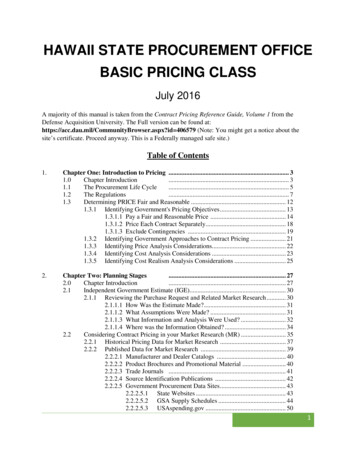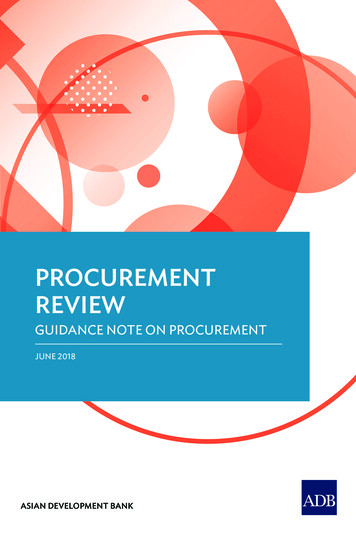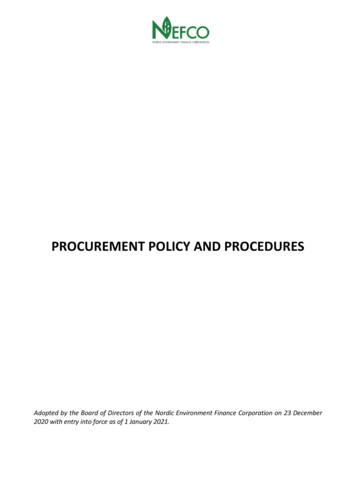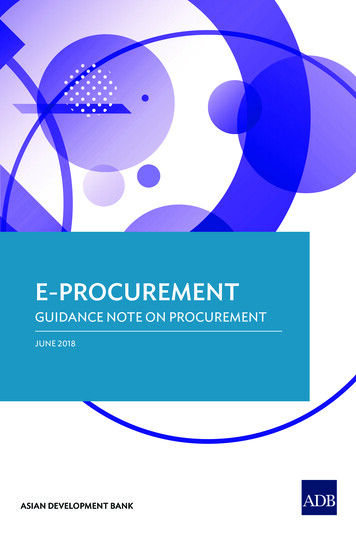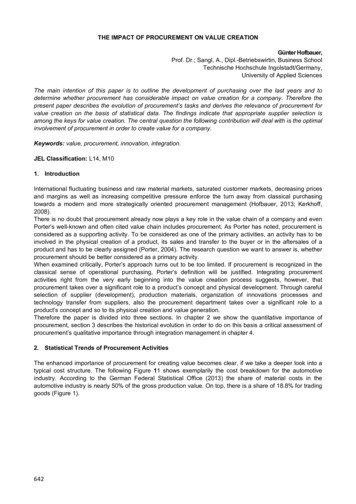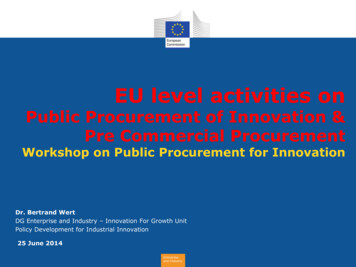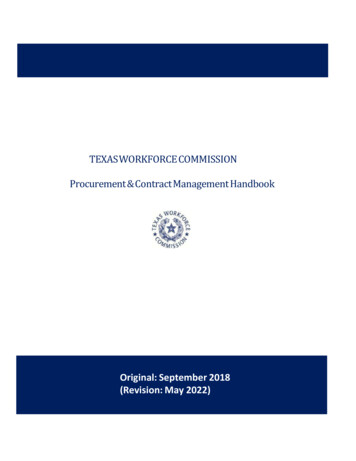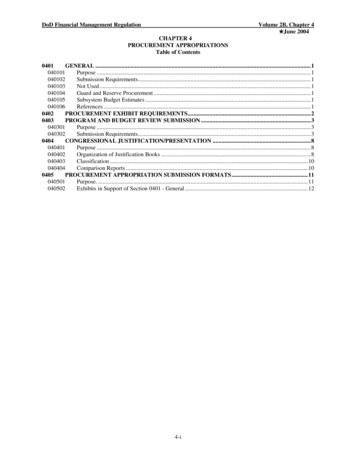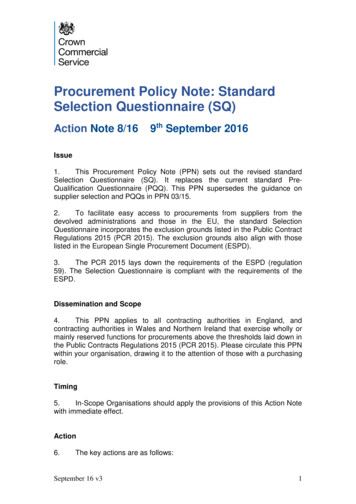
Transcription
Procurement Policy Note: StandardSelection Questionnaire (SQ)Action Note 8/169th September 2016Issue1.This Procurement Policy Note (PPN) sets out the revised standardSelection Questionnaire (SQ). It replaces the current standard PreQualification Questionnaire (PQQ). This PPN supersedes the guidance onsupplier selection and PQQs in PPN 03/15.2.To facilitate easy access to procurements from suppliers from thedevolved administrations and those in the EU, the standard SelectionQuestionnaire incorporates the exclusion grounds listed in the Public ContractRegulations 2015 (PCR 2015). The exclusion grounds also align with thoselisted in the European Single Procurement Document (ESPD).3.The PCR 2015 lays down the requirements of the ESPD (regulation59). The Selection Questionnaire is compliant with the requirements of theESPD.Dissemination and Scope4.This PPN applies to all contracting authorities in England, andcontracting authorities in Wales and Northern Ireland that exercise wholly ormainly reserved functions for procurements above the thresholds laid down inthe Public Contracts Regulations 2015 (PCR 2015). Please circulate this PPNwithin your organisation, drawing it to the attention of those with a purchasingrole.Timing5.In-Scope Organisations should apply the provisions of this Action Notewith immediate effect.Action6.The key actions are as follows:September 16 v31
Stop using the standard Pre-Qualification Questionnaire for thesupplier selection stage of new procurements covered by thePublic Contracts Regulations 2015. Start using the new standard Selection Questionnaire and complywith the guidance, process and the standard form in the attachedannexes. Annex A - Guidance on the selection stage process.Annex B - Standard Selection Questionnaire Template.Annex C - Exclusion Grounds.Annex D - Frequently Asked Questions.Background7.The standard Selection Questionnaire has been developed to simplifythe supplier selection process for businesses, in particular smaller firms,across the public sector. In developing the SQ the opportunity has been takento make the questionnaire compliant with the European Single ProcurementDocument (ESPD), and amended the rules on the selection of suppliers.Contact8.Enquiries about this PPN should be directed to the Crown ilinfo@crowncommercial.gov.uk)September 16 v32
Annex APublic Contracts Regulations 2015Guidance on the selection stage process, including the newstandard Selection QuestionnaireIntroduction1. This document contains statutory guidance on the revised process ofsupplier selection and the new standard Selection Questionnaire to beused. If your organisation is in scope you are required to apply thisguidance when undertaking the supplier selection process inprocurements above the relevant EU thresholds. You should stop usingthe standard Pre-qualification Questionnaire (PQQ). This supersedesthe guidance on supplier selection and PQQs in Procurement PolicyNote 03/15.Background2. Supplier selection is a key stage in public procurement where yougather information on and make assessments of the prospectivebidders' credentials, before considering tenders. This includesgathering information about companies' track records, financialcredentials, whether they have been involved in corruption, whetherthey meet various selection criteria, and so on.3. This new process of supplier selection is very similar to the old one,while introducing some new features and a new form. It modifies andmodernises a longstanding procurement practice, and should not beseen as a major shift in the fundamental approach of supplier selection.It aims to ensure a simpler and more consistent approach across thewhole public sector.4. The standard Selection Questionnaire asks potential suppliers toinitially just self-declare their status against the exclusion grounds andselection questions. Usually you will only check the status of thewinning supplier. This reduces the burden on unsuccessful suppliersand on organisations providing evidence for those checks and alignswith the process required in the PCR 2015 for the ESPD.5. The standard Selection Questionnaire is structured in 3 separate parts:Part 1 of the standard Selection Questionnaire covers the basicinformation about the supplier, such as the contact details, tradememberships, details of parent companies, group bidding and so on.Part 2 covers a self-declaration regarding whether or not any of theexclusion grounds apply.September 16 v31
Part 3 covers a self-declaration regarding whether or not the companymeets the selection criteria in respect of their financial standing andtechnical capacity6. This guidance covers: A summary of the key points More detailed advice on particular aspects, includingo General guidance on scope, format, and deviationso Guidance on particular subsections of the standard SelectionQuestionnaire Standard Selection Questionnaire List of exclusion grounds Frequently asked questionsSummary of Key Points7. You should begin using the new standard Selection Questionnaire(SQ) and stop using the current standard Pre-QualificationQuestionnaire, for the supplier selection stage of new procurementscovered by the Public Contracts Regulations 2015.8. You must tell potential suppliers in the procurement documents howthey are to access the Selection Questionnaire and submit thecompleted version. There are a number of options:a) Include the standard Selection Questionnaire as provided with thisguidance, containing all 3 parts, in the procurement documents; orb) Direct potential suppliers to the EU electronic version of the ESPD,through the Commission's E-ESPD service, and provide the standardselection questions separately in the procurement documents; orc) Provide access details to an e-procurement system that asks thesame questions as listed in the standard Selection Questionnaire plusany procurement specific questions. The e-procurement system couldalso allow potential suppliers to upload SQs completed in othercompatible systems, or re-use SQs from previous procurements thathave been stored in the e-procurement systems.9. You should ensure that all the necessary self declarations are receivedas part of the selection stage evaluation. A Part 1 and Part 2declaration is mandatory from potential suppliers to declare that theyhave not breached any of the exclusion grounds. A completed Part 1and Part 2 declaration is also required of any organisations thatpotential suppliers rely on to meet the selection criteria. These couldbe parent companies, affiliates, associates, or essentialsubcontractors.10. If a potential supplier, or any organisation they rely on to meet theselection criteria, has breached any of the exclusion grounds, theySeptember 16 v32
have the opportunity to explain how and what action they have taken torectify the situation (this is called self-cleaning).11. You must accept a self-assessment of compliance with the exclusionand selection criteria at the early stages of procurement. The evidenceis only required when the winning bidder(s) have been identified, or atan earlier stage if that is necessary to ensure the proper conduct of theprocedure.12. You must not add to or change the questions in Part 1 or Part 2 of thestandard Selection Questionnaire. Deviations are permissible for thesupplier selection questions in Part 3, but must be reported as per theprocess outlined later in this guidance.13. You are obliged to accept the self-certification of the exclusion groundsvia an EU ESPD template, including ones in different formats fromother Member States, if a potential supplier submits one as part of theselection process.14. An EU ESPD template and response to selection questions submittedby a potential supplier from another Member State, can be evaluatedalongside the standard Selection Questionnaire submissions frompotential UK suppliers. The exclusion criteria are common to allMember States, and the instructions on the selection questions for theprocurement will be provided in the procurement documents and will,therefore, be the same for all potential suppliers.General rules for standard Selection Questionnaire15. A declaration that exclusion grounds have not been breached has to beprovided with bids in open procedures. For all other procedures it mustbe provided with requests for participation. However specific contracts(call-offs) placed via frameworks do not require a completeddeclaration.16. In a Dynamic Purchasing System (DPS) the standard SelectionQuestionnaire Part 1 and Part 2 must form part of the selection criteriafor entry onto the DPS. An update to these Parts 1 and Part 2 can beasked for at any time during the life of the DPS. You may use Part 3 ofthe standard Selection Questionnaire as a guide in developingappropriate and proportionate questions for the supplier selectioncriteria of a DPS.17. The procurement documents must provide details on how the selfdeclaration of exclusion grounds section of the questionnaire is to beaccessed, list the required selection questions, and tell potentialsuppliers how to submit responses to the three Parts.18. Currently there are three ways for a potential supplier to access theexclusion grounds self-declaration (Part 1 and Part 2 of the SQ). Thebest route for you to select depends on the facilities available to you: Standard Selection Questionnaire. Potential suppliers are askedto complete the standard Selection Questionnaire and submit aSeptember 16 v33
copy alongside the selection evidence. The standard SelectionQuestionnaire can be found at Annex B. This route can only beused until 18th April 2017 after which all submissions must beelectronic and are likely to be incorporated into contractingauthorities e-procurement systems. The exclusion questionsprovided in Part 2 of the template should be supplemented withthe relevant standard supplier selection questions listed in Part3. An alternative way of doing this is to ask the selectionquestions separately within the procurement documentation.Guidance for the use of standard supplier selection questions isprovided below. EU E-ESPD Service (E-ESPD). This is an online version of theEU ESPD and only covers Part 1 and Part 2 of the standardSelection Questionnaire. You create the ESPD template andinclude the downloaded XML document with the procurementdocuments, alongside the standard supplier selection questionsand request for selection information. The potential supplieruploads the XML file to the E-ESPD and completes the selfdeclaration. The potential supplier completes the E-ESPD intheir own language against their own national exclusiongrounds, and the E-ESPD provides the translations. Thepotential supplier then downloads the completed XML file andattaches it with their selection evidence/bid. Upon receipt of thefile you upload it into the E-ESPD system to check it. Using thisroute, Part 3 supplier selection questions are asked separatelyin the procurement documents. E-procurement system. The self-declaration on the exclusiongrounds can be built into interoperable e-procurement systemsthat allow the answers to be reused and exchanged between eprocurement systems both nationally and across MemberStates. If this option is selected the procurement documentssimply provide the link to the e-procurement system, provided itoffers unrestricted and full direct access free of charge to allpotential suppliers. The EU Commission has also providedcoding that facilitates the exchange of ESPD data between eprocurement systems. If you have an existing e-procurementsystem then the system’s providers can download the code fromJoinUp or github.com and incorporate the exclusion groundssection within their own e-procurement system.19. To reduce the administrative burden of a procurement procedure,documentary evidence is not required when the standard SelectionQuestionnaire is submitted. Where the evidence is available in arelevant national database, free of charge, the potential supplier canstate where the requested evidence can be found (i.e. the name of therepository, website, identification of the file etc.). If this happens youmust retrieve it directly from the indicated source.20. However you may ask any potential supplier at any time during theprocurement to submit all or part of the evidence if it is necessary toensure the proper conduct of the procedure. You must check theevidence of the winning bidder before award of the contract.September 16 v34
Guidance on Part 1 and Part 2 (exclusion grounds1) - keyprinciples21. It is mandatory for a potential supplier to complete Part 1 and Part 2 ofthe standard Selection Questionnaire, or the ESPD template, for allprocurements above EU thresholds.22. As Part 1 and Part 2 of the standard Selection Questionnaire provide aformal statement that the relevant grounds for exclusion do not apply tothe potential supplier completing it, a completed form is required foreach organisation the potential supplier will rely on to meet theselection criteria. This also means that where the potential supplier isactually a group of suppliers, including joint ventures and partnerships,each potential supplier in that group must complete Part 1 and Part 2 ofthe standard Selection Questionnaire self-declaration. This requirementmust be made clear in the procurement documents.23. You can choose whether or not to ask for a self-declaration ofexclusion grounds from sub-contractors who are not being relied on bythe bidder to meet the selection criteria. However if you choose to askfor one then the procurement documents should explicitly state thatone is required. (The standard Selection Questionnaire includes a lineto this effect).Guidance on Part 3 of standard Selection Questionnaire andqualitative selection – key principles24. You must consider this guidance for procurements above the EUthresholds for supplies and services when selecting potential suppliers.This guidance is accompanied by the standard Selection Questionnairefor use in procurements where the PCR 2015 apply.25. The threshold for using a pre-qualification stage in a works contract isthe same as for supplies and services. You should use the PAS91PQQ for works contracts (including the procurement of goods andservices needed in relation to the works).26. The section of the guidance covering standard supplier selectionquestions (Part 3 of the standard Selection Questionnaire) does notapply to: contracting authorities which exercise wholly or mainly devolvedfunctions in Wales or Northern Ireland; the procurement of health care services for the purposes of theNHS within the meaning and scope of the National HealthService (Procurement, Patient Choice and Competition) (No. 2)Regulations 2013.1List of exclusion grounds can be found oads/attachment data/file/551130/List ofMandatory and Discretionary Exclusions.pdfSeptember 16 v35
Below threshold procurements27. You must not include a pre-qualification stage in any procurementbelow the EU thresholds for supplies and services. The standardSelection Questionnaire exclusion questions and standard selectionquestions may be used as a guide in developing appropriate andproportionate questions as part of a one-stage procurement process. Inbelow threshold procurements questions may be asked to assess thesuitability, capability, legal status, and financial standing of a potentialsupplier, provided that the questions are relevant and proportionate.For works contracts valued between the supplies and servicesthreshold and the works threshold you may use a two stage processand make use of the PAS91 PQQ.Use of selection questions28. The questions included in Part 3 of the standard SelectionQuestionnaire should be adopted across all relevant procurementprocedures over the threshold. You do not have to use all thequestions - only those relevant and proportionate to the contract.29. The questions should be used in line with the relevant procurementprocedure, and used: as part of the tender pack to test that a potential supplier meetsminimum levels of suitability when using the open procedure; to pre-qualify suppliers to be invited to tender when using therestricted procedure; to submit an initial tender under the competitive procedure withnegotiation; or to participate in a competitive dialogue, innovationpartnership procedure or Dynamic Purchasing System (DPS).30. If the standard selection questions are presented as a separatedocument you should ensure that an appropriate declaration isincluded and a signature obtained.Reportable deviations31. No changes or additions can be made to questions in Part 1 and Part 2of the standard Selection Questionnaire as they list the exclusiongrounds set out in the PCR 2015.32. The expectation is that you do not deviate from the questions set out inPart 3 of the standard Selection Questionnaire. However, if you dodeviate from this guidance, you must report this to the ations@crowncommercial.gov.uk).33. You must report the following deviations:September 16 v36
o changes to the wording of the standard questions andinstructions;o additional questions that are included which are notspecific to the individual procurement.34. The report (for information purposes only, and not for approval) shouldinclude:o a covering letter or e-mail explaining the reasons for anydeviations, demonstrating that they are relevant,proportionate and linked to the requirements of thecontract and contract delivery.o confirmation that the deviations have been approved bythe Head of Procurement or equivalent in theorganisation.o a copy of the questions template or supplier selectionprocess which clearly shows the deviations. This couldinclude a document summarising the deviations.35. You do not need to report:o project specific questions developed in line with thisguidanceo simple amendments to make the questions compatiblewith e-procurement systemso standard questions which you have decided to omit.36. You are only required to report once to explain deviations. A report isnot required for each procurement. If you make further changes thosedeviations should be sent to the Mystery Shopper scheme.37. The Mystery Shopper scheme conducts spot checks on procurementdocuments for public sector contracts to ensure compliance.Self-declarations38. You should normally allow potential suppliers to self-declare that theymeet the relevant criteria in the supplier selection stage. Only thewinning supplier (and any organisations relied upon to meet thewinning supplier's selection criteria) should submit evidence. Thisreduces the need for potential suppliers to submit supportingdocuments every time they wish to bid for a public contract.39. If the winning supplier fails to provide the required evidence within settimeframes, or the evidence proves unsatisfactory, the award of thecontract should not proceed. You may then choose to amend thecontract award decision and award to the second-placed supplier,provided that they have submitted a satisfactory bid. Alternatively, theprocurement process may be terminated.September 16 v37
40. You can require information from any supplier at any stage if it isnecessary to ensure proper conduct of the procurement procedure. Ina two-stage procedure, it might be necessary to ask for the informationbefore the award stage. You should ask for evidence that isproportionate and relevant to the procurement. The approach shouldbe clearly set out in the procurement documents.Group of potential suppliers41. If the potential supplier is bidding on behalf of a group, for example, aconsortium, or intends to use sub-contractors, there are differentactions required for completion of Part 3 of the standard SelectionQuestionnaire compared to Part 1 and Part 2.42. The consortium lead should complete all of the questions on behalf ofthe consortium and/or any sub-contractors. The consortium lead shouldmake it clear who the lead member of the group is, and who will becontractually responsible for delivery of the contract.43. All members of the group are required to provide the informationrequired in Part 3 of the standard Selection Questionnaire orprocurement documents, as part of a single composite response(unless the question specifically directs otherwise). You may requiremembers of the group to assume a specific legal form if awarded thecontract, if considered necessary for the satisfactory performance ofthe contract. Where the group is proposing to create a separate legalentity, such as a Special Purpose Vehicle (SPV) or consortium, theyshould provide details of the actual or proposed percentageshareholding of the constituent members within the new legal entity.They should also provide the name for the new entity and details of itslegal and operational structure. An SPV is a legal entity that is formedto perform a specific contract.44. Consortium arrangements may be subject to change, and you shoulduse the evaluation criteria to make it clear that any updates to this orany other bidding model should be provided to you during theprocurement process. This is to allow you to request a self-declarationof the exclusion grounds (Part 1 and Part 2 of the standard SelectionQuestionnaire) for any new organisation, and carry out a furtherassessment using the standard selection questions and any specificselection criteria. You should also use the evaluation criteria to reservethe right to deselect a potential supplier or a group prior to any awardof contract, based on an assessment of the updated information.Guidance on supplier selection questionsEconomic and financial standing45. Any minimum financial requirements should be clearly stated. Themethodology for assessing economic and financial standing should plier financial risk provides further information.September 16 v38
46. You should normally allow potential suppliers to self-certify that theymeet minimum financial requirements when assessing economic andfinancial standing. Checks against self-certification should only becarried out on the winning supplier. The questions in this sectionassume that information will only be required from the winning supplier,but in the event that evidence is required at an earlier stage of theprocurement process, the wording in question 4.1 should be amendedto say “Please indicate which of the following you have provided todemonstrate your economic/financial standing”.47. The financial assessment method used depends on the requirement.You do not have to use every question in this section - only thosewhich are relevant and proportionate. If you decide to use a differentmethod of financial assessment you need to report this as a deviation.You should not deselect potential suppliers on the basis of turnover ora credit check alone.Technical and professional abilityPast Performance48. You may evaluate the past performance of a potential supplier.Suppliers may be required to have sufficient level of experiencedemonstrated by suitable references.49. You may request details of contract examples or references from eitherthe public or private sector that are relevant to the requirement. Thenumber requested should be relevant and proportionate - the questionsask for three examples. Contracts for supplies or services should havebeen performed during the past three years. Contracts for worksshould have been performed during the past five years. The criteria forevaluating the responses from suppliers should not be discriminatory ordisproportionate towards smaller businesses.50. To assess whether a potential supplier has the required level ofexperience use the template provided in section 6.1. Potential suppliersshould be asked to submit details of contracts where the namedcustomer contact is prepared to provide written evidence to confirm theaccuracy of the information provided. Customer references should befactual.51. You may ask the lead supplier to provide a relevant example whereone or more group members have delivered similar requirements. Ifthis is not possible (for example a consortium is newly formed or anSPV will be created for the contract) up to three separate examplesshould be provided from the principal members of the group. Thisapproach will help you establish that the new entity demonstrates therequired level of experience.Sub-contractors and supply chains52. Bids submitted by a potential supplier proposing to use sub-contractorsshould provide a relevant example where one or more of the essentialSeptember 16 v39
sub-contractors have delivered similar requirements (separateexamples are not required from each sub-contractor). You should usequestion 6.2 which asks about capability to maintain a healthy supplychain, including paying sub-contractors promptly.Modern Slavery Act 2015253. Since 1 October 2015, commercial organisations that carry on abusiness or part of business in the UK, supply goods or services andhave an annual turnover of 36 million or more ("relevant commercialorganisations") have been required under Section 54 of the Act toprepare a slavery and human trafficking statement as defined bysection 54 of the Act.Additional questionsProject Specific Questions54. You can ask further project-specific questions relating to the potentialsupplier’s technical and professional ability. Any project-specificquestions asked must be relevant and proportionate to the contract.You should refer to the list of possible topics covering technical andprofessional ability.Insurance55. You should allow potential suppliers to self-certify that they have, or willhave in place, any required insurance in the event that they areawarded the contract. It is not appropriate at this point to insist onevidence that cover already exists. You should specify the level ofcover required on a case by case basis. This should be proportionateand reflective of the nature of the work and the risk involved. Anyreason for requiring insurance above that required by law should bejustifiable.Questions to be used primarily by central governmentorganisationsSkills and Apprenticeships56. Procurement Policy Note 14/15 provides guidance on skills andapprenticeships. Selection criteria may be used to assess the skills andapprenticeships provided in bids for relevant contracts with a value of 10 million and above, and a duration of 12 months or more. Question8.2 in the standard supplier selection questions should be used bycentral government organisations, and other contracting authorities areencouraged to consider skills and apprenticeships where relevant.2For background see Home Office ystem/uploads/attachment data/file/471996/Transparency inSupply Chains etc A practical guide final .pdfSeptember 16 v310
Steel57. For contracts where the procurement of steel is a component, theadvice in Procurement Policy Note 16/15 in major projects should befollowed and the questions at 8.3 of the standard supplier questionsshould be included.Suppliers Past Performance - central government organisations58. Procurement Policy Note 04/15 sets out a formal process for takingaccount of past performance for specific central government contractsover 20m in value. Part A of PPN 04/15 provides guidance forestablishing selection criteria relating to a supplier’s reliability. Thisadvice should be followed for relevant central governmentprocurements and the appropriate notices, as set out in the PPN, mustbe included in procurement documents. See question 8.4.September 16 v311
Annex BStandard Selection QuestionnairePotential Supplier Information and Exclusion Grounds: Part 1 and Part 2.The standard Selection Questionnaire is a self-declaration, made by you (thepotential supplier), that you do not meet any of the grounds for exclusion3. If thereare grounds for exclusion, there is an opportunity to explain the background and anymeasures you have taken to rectify the situation (we call this self-cleaning).A completed declaration of Part 1 and Part 2 provides a formal statement that theorganisation making the declaration has not breached any of the exclusions grounds.Consequently we require all the organisations that you will rely on to meet theselection criteria to provide a completed Part 1 and Part 2. For example these couldbe parent companies, affiliates, associates, or essential sub-contractors, if they arerelied upon to meet the selection criteria. This means that where you are joining in agroup of organisations, including joint ventures and partnerships, each organisationin that group must complete one of these self-declarations. Sub-contractors that yourely on to meet the selection criteria must also complete a self-declaration (althoughsub-contractors that are not relied upon do not need to complete the selfdeclaration).When completed, this form is to be sent back to the contact point given in theprocurement documents along with the selection information requested in theprocurement documentation.Note for Contracting Authorities: The following paragraph is optional forinclusion, authorities can delete it if they prefer to receive only Word/ PDFversions of the standard Selection Questionnaire. [Alternatively you can submitthe completed Exclusion Grounds of the EU ESPD (Part III) as a downloaded XMLfile to the buyer contact point along with the selection information requested in theprocurement documentation.]Supplier Selection Questions: Part 3The procurement document will provide instructions on the selection questions youneed to respond to and how to submit those responses. If you are bidding on behalfof a group (consortium) or you intend to use sub-contractors, you should complete allof the selection questions on behalf of the consortium and/or any sub-contractors.If the relevant documentary evidence referred to in the Sel
Selection Questionnaire (SQ) Action thNote 8/16 9 September 2016 Issue 1. This Procurement Policy Note (PPN) sets out the revised standard Selection Questionnaire (SQ). It replaces the current standard Pre-Qualification Questionnaire (PQQ). This PPN supersedes the guidance on supplier selection and PQQs in PPN 03/15. 2.
